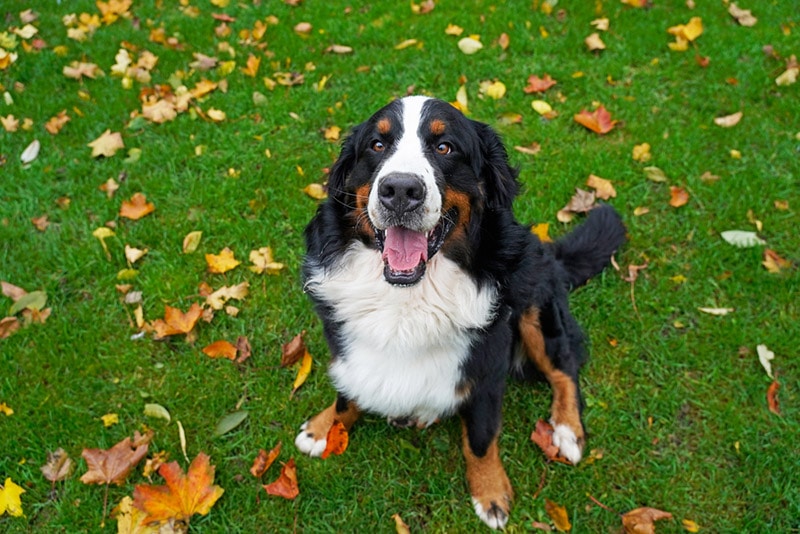One of the most frustrating parts of bringing a new dog into the home is potty training them. And with a Bernese Mountain Dog, those frustrations can feel massive, largely because of the huge messes they leave behind.
But while it’s undoubtedly a frustrating experience, there are a few tips and tricks you can follow to help potty train them a bit quicker and more effectively. We’ve highlighted 9 tips and tricks that you should follow when potty training this large breed.

The 9 Tips to Potty Train a Bernese Mountain Dog
1. Take Them Out a Lot

It’s one of the most important things to do when trying to potty train any dog, and it can also be one of the most annoying. During the potty-training time frame, you want to start by taking them out every 2 hours, then slowly increasing the time between outdoor visits as they improve.
It’s a lot of work but it’s the most effective way to potty train your pup. The good news is that the outdoor potty breaks shouldn’t last for too long if you take them out frequently enough.
2. Crate Training
Crate training is one of the most successful ways to potty train a dog, but it certainly comes with its fair share of controversy. Most animal professionals agree that there’s nothing wrong with crate training, but it can still break our hearts seeing them in there.
When crate training, let your dog outside every 30 minutes or so, and when they use the bathroom outside, let them stay outside of their crate for a bit. If they don’t go to the bathroom when they’re out, they go back into the crate.
This is effective because most dogs won’t go potty in a crate since it’s a confined space. They hold it, and when you let them outside, they go there. You reward them for the behavior and before long, they know they’re supposed to use the bathroom outside!
3. Use a Feeding Schedule

Jumpstarting a pup’s digestive tract is a surefire way to get many of them to use the bathroom. Because of this, you want to stick with a consistent feeding schedule at consistent times to keep your digestive system in order.
Take them out 15 minutes after feeding to help reduce the likelihood of any accidents in your home.
4. Only Use Positive Reinforcement
It can be more than a little frustrating when your pup messes in the house, but when potty training, you need to stick with positive reinforcement and avoid any negative reinforcement. If they mess in the house, clean it up and ignore it—don’t scold your pup for it.
If you scold them, all it will do is make your pup hide it the next time. You want to be able to spot the warning signs beforehand, and you want them to feel comfortable going in front of you when they’re outside.
5. Use Rewards

Pups love rewards, and nothing gets them interested in something like a tasty treat. Rewards or treats are a great way to speed up the potty training process a bit, just ensure you slowly start to wean them off as they get the hang of things.
Keep rewarding them with positive reinforcement, but there’s no reason to give them a treat every time they use the bathroom for the rest of their lives!
6. Stick to a Schedule
Dogs love consistency so if they know when they can expect a trip outside, they’re more likely to hold it until then. While you don’t need to stay consistent with taking them out every 30 minutes forever, you should have a few set times throughout the day that you always let your dog outside.
7. Go to the Same Spot

When you take your pup outside to use the bathroom, always take them to the same spot. This will help them form memories of what they should do while they are there. Once your pup is comfortable with their time outside, there’s no reason you can’t take them to different places on your trips out.
8. Look for Signs
Dogs will start giving off some telltale signs when looking for a place to use the bathroom. Common signs include sniffing more than usual, circling, wandering off, whining, or sitting by the door. If you ignore these signs, they’re going to have an accident in the house, and this time it’s more on you!
9. Avoid Potty Pads
Potty pads are a controversial topic, but we firmly believe that you should only use them as a last resort. If you start using potty pads, your pup will learn that it is an acceptable place to go, even if you want them to go outside.
However, potty pads can be beneficial if you don’t have somewhere you can take them outside or if your dog is suffering from a medical condition where they can’t hold it.
No matter how hard you try, pets will always leave you cleaning up smells, stains, vomit, hair, and everything in between. With the Hepper Advanced Bio-Enzyme Pet Stain & Odor Eliminator Spray, you can advance your clean-up routine!
- ADVANCED ENZYMATIC CLEANER - Penetrates the most stubborn smells and stains at the deepest molecular...
- FOR ANY MESS, ON ANY SURFACE - This pet odor eliminator cleans your carpets, floors, furniture,...
- FRESH, NATURAL ODOR - Our unique formulation doesn't rely on dangerous or unpleasant chemical...
It permanently removes the very worst pet stains and smells (and truly makes clean-up a breeze). Click here to learn more, order a bottle, and freshen up your home today.
At Dogster, we’ve admired Hepper for many years, and decided to take a controlling ownership interest so that we could benefit from the outstanding products of this cool pet company!

How Long Should Puppy Potty Training Take?
If you’re hoping your dog will pick up on potty training just like that, you might want to readjust your expectations a bit. Most puppies will take 4 to 6 months to fully potty train, and sometimes it can take up to a year.
This is especially true if your puppy already has some bad habits they need to break. Stay consistent and follow as many of our tips as possible and you can speed up the process a bit, but if you can fully house-train your Bernese Mountain Dog in 4 months, you’ve done an outstanding job.

In Conclusion
While it might seem like it’s taking forever to potty train your Bernese Mountain Dog, if you stick with it and keep following the tips above, they’ll be past this stage before long and you can put these frustrations behind you.
The key is to stay consistent with it and keep providing positive reinforcement. Your pup wants to make you happy; it might just take them a little while to figure out how!
Featured Image Credit: Kristesoro, Shutterstock





















